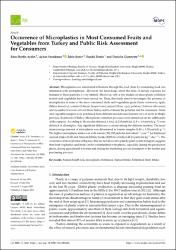| dc.contributor.author | Daniela Giannetto | |
| dc.contributor.author | Aydın, Rana Berfin | |
| dc.contributor.author | Yozukmaz, Aykut | |
| dc.contributor.author | Temiz, Funda | |
| dc.date.accessioned | 2023-09-05T13:17:50Z | |
| dc.date.available | 2023-09-05T13:17:50Z | |
| dc.date.issued | 2023 | en_US |
| dc.identifier.citation | Aydın, R.B.; Yozukmaz, A.; Şener, İ.; Temiz, F.; Giannetto, D. Occurrence of Microplastics in Most Consumed Fruits and Vegetables from Turkey and Public Risk Assessment for Consumers. Life 2023, 13, 1686. https://doi.org/10.3390/life13081686 | en_US |
| dc.identifier.issn | 2075-1729 | |
| dc.identifier.uri | https://doi.org/10.3390/life13081686 | |
| dc.identifier.uri | https://hdl.handle.net/20.500.12809/10936 | |
| dc.description.abstract | Microplastics are transferred to humans through the food chain by consuming food con-
taminated with microplastics. However, the knowledge about the risks of dietary exposure for
humans to these particles is very limited. Moreover, only a few studies on microplastic pollution
in fruit and vegetables have been carried on. Thus, this study aims to investigate the presence of
microplastics in some of the most consumed fruits and vegetables (pear (Pyrus communis), apple
(Malus domestica), tomato (Solanum lycopersicum), onion (Allium cepa), potatoes (Solanum tuberosum),
and cucumber (Cucumis sativus)) from Turkey and to evaluate the potential risk for consumers. Fruits
and vegetable samples were purchased from different markets and fruiterer (two of each) in Mu ˘gla
province, Southwest of Turkey. Microplastic extraction processes were carried out on the edible parts
of the samples. According to the results obtained, a total of 210 particles (2.9 ± 1.6 particle g−1) were
detected in all samples. Any significant difference occurred among the different markets. The maxi-
mum average amount of microplastic was determined in tomato samples (3.63 ± 1.39 particle g−1).
The highest microplastic intake was with tomato (398,520 particles individual−1 year−1 for Estimated
Annual Intake (EAI) and Estimated Daily Intake (EDI) for children 68.24 particles kg−1 day−1). The
occurrence of microplastics of big size, that are not allowed to pass by plant xylem transport, suggests
that fresh vegetables and fruits can be contaminated with plastic, especially during the production
phase, during agricultural activities and during the marketing process (transport to the market and
purchasing process). | en_US |
| dc.item-language.iso | eng | en_US |
| dc.publisher | MDPI | en_US |
| dc.relation.isversionof | 10.3390/life13081686 | en_US |
| dc.item-rights | info:eu-repo/semantics/openAccess | en_US |
| dc.subject | Human health risk | en_US |
| dc.subject | Microplastic | en_US |
| dc.subject | Estimated Annual Intake | en_US |
| dc.subject | Estimated Daily Intake | en_US |
| dc.title | Occurrence of Microplastics in Most Consumed Fruits and Vegetables from Turkey and Public Risk Assessment for Consumers | en_US |
| dc.item-type | article | en_US |
| dc.contributor.department | MÜ, Fen Fakültesi, Biyoloji Bölümü | en_US |
| dc.contributor.authorID | 0000-0002-3895-5553 | en_US |
| dc.contributor.authorID | 0000-0003-2575-3044 | en_US |
| dc.contributor.institutionauthor | Daniela Giannetto | |
| dc.contributor.institutionauthor | Yozukmaz, Aykut | |
| dc.contributor.institutionauthor | Aydın, Rana Berfin | |
| dc.contributor.institutionauthor | Temiz, Funda | |
| dc.identifier.volume | 13 | en_US |
| dc.identifier.issue | 8 | en_US |
| dc.relation.journal | Life | en_US |
| dc.relation.publicationcategory | Makale - Uluslararası Hakemli Dergi - Kurum Öğretim Elemanı | en_US |


















